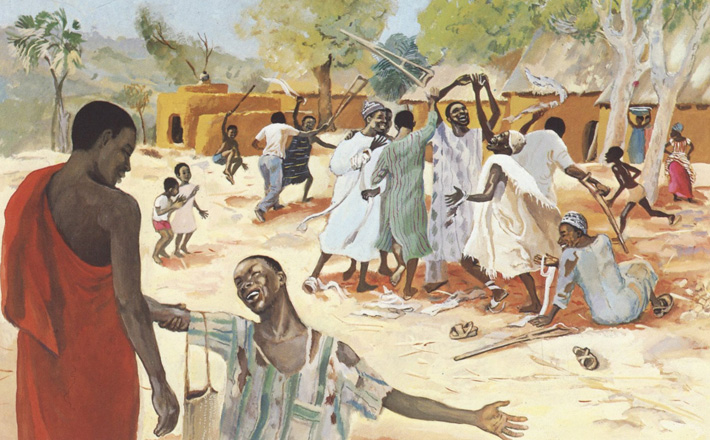Commentary on 2 Timothy 2:8-15
If Timothy hasn’t yet figured out that success in his ministry isn’t predicated on his creativity and insight, this part of the letter might fix that.
So far, the letter has exhorted Timothy to learn from Paul’s example in suffering (see the commentary on last Sunday’s reading), from others in their faithfulness or lack of it (see 2 Timothy 1:15-18), and from common examples of people who practice single-minded commitment, discipline, and hard work (see 2 Timothy 2:1-7).
The Reliability of Jesus and the Gospel (2:8-13)
Beginning in 2 Timothy 2:8, the advice turns to consider an additional, superior exemplar: “Remember Jesus Christ.” Because Jesus lives as one “raised from the dead,” he remains a sure sign that “the word of God is not chained.” In 2:9, “the word of God” refers to the gospel message. Jesus could not be confined by death, and so the good news about Jesus cannot be confined by persecution or shame. Accordingly, Paul’s own sufferings and incarceration cannot restrict or tarnish his legacy of faithfulness. The point of the expression “for the sake of the elect” in 2:10 is not that Paul’s hardships produce salvation for others; rather, he enacts the gospel message through his willingness to suffer persecution faithfully, preaching by his example so as to encourage perseverance among the saints.
Paul quotes most likely from a Christian hymn in 2:11b-13a to remind readers that perseverance is neither merely his own pet project, nor is it optional. It is a trademark of Christian life and service, a manifestation of our union with Christ.
The hymn’s first two lines work in parallel, each one asserting the positive outcomes of (first) our identification with Christ and (second) our perseverance. The third line states a kind of equivalence or reciprocation: our denial of Christ results in his denial of us. Then, perhaps generating surprise, the fourth line says our negative action, faithlessness, will not be reciprocated by faithlessness on Christ’s part, for “he remains faithful.” The final words in verse 13, “for he cannot deny himself,” probably represent the author’s commentary on the hymn’s last claim. They assert, following the lead of established Jewish convictions about God that Christ must remain faithful to his own self, character, or commitments.
The big interpretive question here is how the hymn’s third and fourth lines (2 Timothy 2:12b-13a) relate to each other. People who are uncomfortable with the notion of God denying us tend to say that the fourth line trumps the third, that God’s generous faithfulness to us will keep God from ultimately denying those who falter. In contrast, others read the line about God’s steady faithfulness as indicating God’s commitment to justice: when God denies the deniers, that’s just God doing what divine holiness requires. As you consider this question, notice that elsewhere the letter holds out hope for those it considers Timothy’s opponents (2:25b-26). The overall sweep of the letter also insists that the gospel’s influence or reliability cannot ultimately be nullified by the faithlessness or destructive behavior of some.
Preaching in Light of 2:8-13
Scripture abounds with reassurances of God’s fidelity to people and to the covenants that benefit them. What does it mean to claim reliability as a fundamental aspect of God’s character? Sometimes this emphasizes God’s consistency, God’s grace distributed generously through a steady, predictable demeanor. It can also point to God’s incorrigibly relational nature, to a God who initiates and sustains relationships with undeserving creatures God simply can’t help but love with abandon, because maybe God cannot be comprehended except through such connections. As Second Timothy implores us to “remember Jesus Christ,” that’s what I remember.
What Timothy Is Supposed to Do (2:14-15)
The letter begins a new movement in 2 Timothy 2:14 (extending through 3:9), making the lectionary’s addition of 2:14-15 perplexing. Whatever the reason for including these verses, they give a quick taste of what the letter expects Timothy to do as a Christian leader; for in this section Timothy receives instruction about teaching others so he might counteract those who “oppose the truth” (see 2 Timothy 3:8).
Who are the “them” that Timothy must speak to in 2:14? It could be all of “the elect” mentioned in 2:10, or it might refer to a smaller set of believers, certain “faithful people” designated as leaders who also teach others (2:2). In any case, the focus here is on how Timothy prepares those within the church’s orbit to withstand the threats they face. His work involves teaching and reminding.
The admonition against “wrangling over words” in 2:14 gives very little insight into the letter-writer’s specific concerns. The expression suggests that Timothy should not get himself into public debates or verbal scrapes over doctrine (see also 1 Timothy 1:3-7; 6:3-5; Titus 3:8-11). Presumably, the letter’s original readers knew what the exact controversies and disagreements were. Despite what remains unknown to us, the letter is clearer about the strategy it commends to Timothy: do not convene discussions with rival teachers but rather explain “the word of truth” (see also 2 Timothy 2:24-26). If today this kind of approach to ministry offends our notions of collaborative, generous leadership, we might refrain from holding that offense too tightly. Since we don’t know the details of the controversies, we can’t be sure of the damage they might have been inflicting on the community that first received this letter. In short, it’s difficult to tell if the author is being imperious about his notion of orthodoxy or if he’s trying to protect a battered, self-destructive community from suffering additional harm.
Preaching in Light of 2:14-15
The singularly most important theological contribution the Pastoral Epistles (this letter, plus First Timothy and Titus) make is in forcing readers to consider the question of how Christians face situations of conflict, change, and other challenges of acculturation. How do we carry old convictions and confessions into new, uncertain, and sometimes unsettling settings? It’s an unavoidable question, and we answer it all the time, even if we aren’t aware we are doing so.
The Pastoral Epistles’ answer to this question is, put simply: hold onto established conventions, preserve received tradition, and hold it in trust for future believers, and avoid practices and ideas that may offend cultural conventions about what counts as respectable behavior.
Because of what I read elsewhere in the Bible and what I have seen in church history, I am more likely to preach against this answer than to preach it, at least in the current American context. That context, I admit, looks very different from the one this letter spoke to in the early second century. But I am happy that the Pastoral Epistles raise the question so bluntly and that they answer it uncomfortably (for me), because today we need to address the question frankly and smartly, learn from the church’s past mistakes and accomplishments, and walk into the future leaning on God with humility and boldness.


October 13, 2013